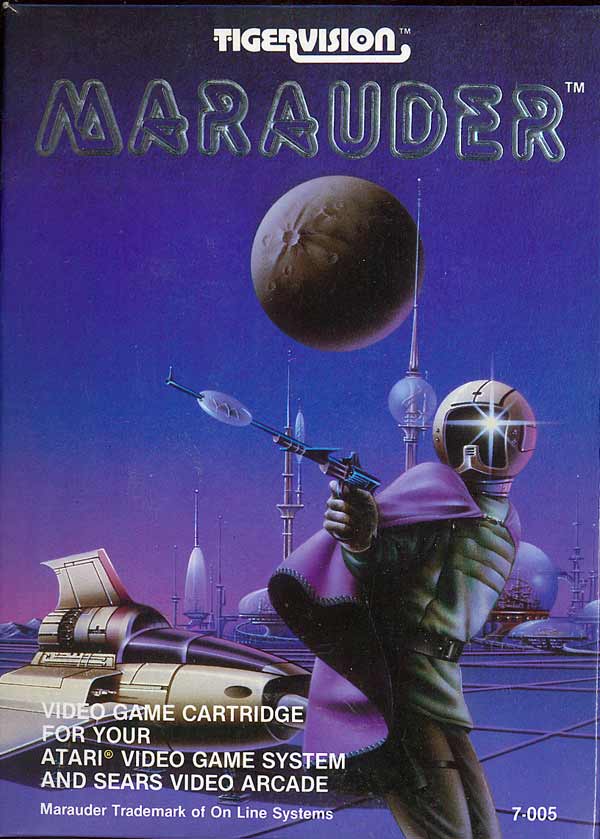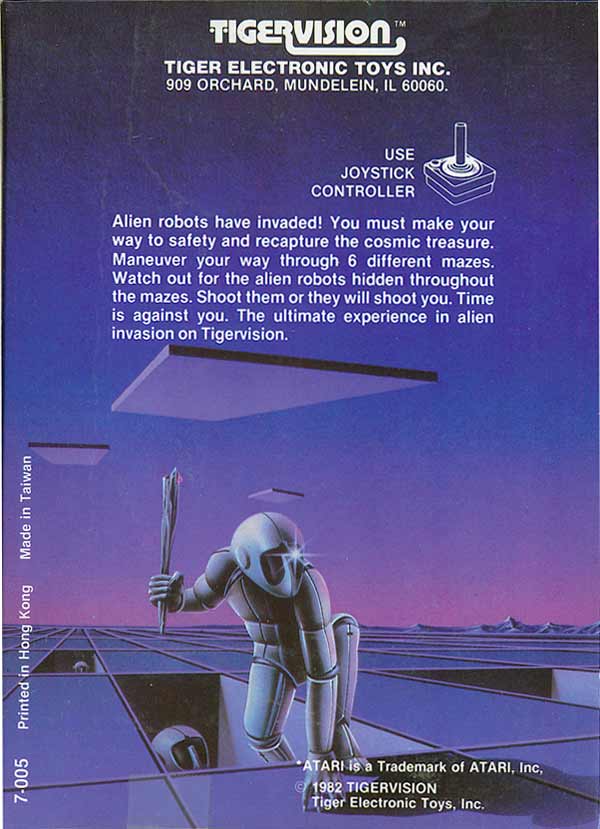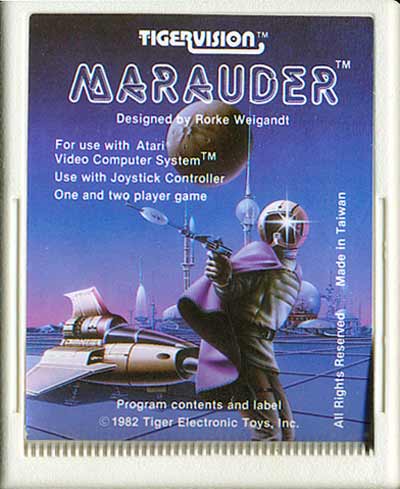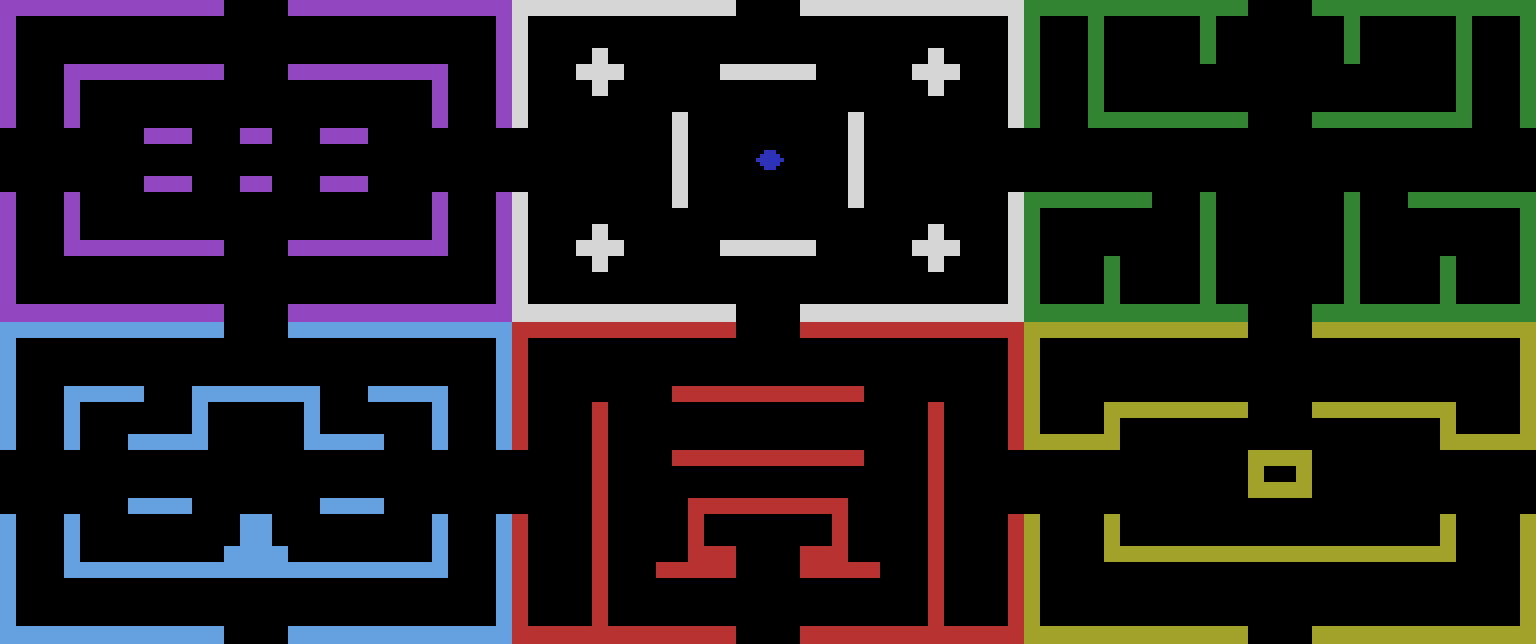TigerVision's Marauder:
A Distinctive Robot Shooter
By Adam Trionfo and Chris Federico

Adam's View...
First impressions are everything. As a science-fiction reader, I have always loved the cover art of the 1970s-era paperback books that I grew up reading. The box art of TigerVision's Marauder is firmly entrenched in this era, but there are also hints of magazine covers from the 1930s and 1940s. The Marauder is wearing a spacesuit and a purple cape. The moon hangs heavy in the background. It is so low that it just might actually be in the foreground, ready to topple into the city-in-a-bubble at any moment.
The Marauder points his Flash Gordon-type laser pistol at unseen enemies that are likely chasing close behind him (if you turn the box over, the wrap-around art shows that these enemies are robots, and certainly are breathing down his neck). The Marauder must make his way to his nearby, airplane-like spaceship to make his escape.
In just looking at the box art, I already have a good feeling about Marauder without having ever played the game. I know that my emotions have been preyed upon. This is all advertising trickery. Yet, just like devious advertisers are hoping, I want to try out this game. I'll take it home with me... plug it into my Atari 2600 console... discover, just like I discovered with those science-fiction books again and again, that the artwork has nothing whatsoever to do with the game.
In the case of the Atari 2600, the way the game actually looks can never, ever stand up to box art like this. Going into a game knowing this helps to dampen the impact from the game’s top view, the Marauder himself (who looks a bit like Pac-Man when he walks), and the fact that nothing at all from the box art's background is actually in the game.
This is all okay with me. It is 2011 and I'm playing a game on the Atari 2600, a game system that is nearing thirty-five years old. I'm not looking for a game that looks like a movie. I'm not looking for a game that looks better than a movie. I don't want to be taken into the third dimension. I'm playing this game because I'm hoping to find a fun game that will allow me to quickly play here and there. I don't want to invest fifteen hours in a deep plot. I'm willing to invest fifteen minutes. Does Marauder hold my attention for even that long? Yes, it most certainly does!
My impression of what the game holds for me from the box art is not really what Marauder is all about. So, what is it all about? I'll let the box explain it all:

"Alien robots have invaded! You must make your way to safety and recapture the cosmic treasure. Maneuver your way through six different mazes. Watch out for the alien robots hidden throughout the mazes. Shoot them or they will shoot you. Time is against you. The ultimate experience in alien invasion on TigerVision."
Just as looking at Atari 2600 box art doesn't give a true picture of what the game entails, neither does reading the back of an Atari 2600 box explain to me what the game is really about. Let's see here. Are there hidden robots? Check! Treasure? I haven't seen any. Mazes? Sure, if you can count a wall or two between the exits. Is there a time limit? Yup. Is this the ultimate in alien experience from TigerVision? It could be. That's sort of a cheat though, as TigerVision only has two other space-related Atari 2600 games: Espial and Threshold. Maybe it wins "ultimate" by default.
.gif)
Now that I've read the back of the box, what does the manual have to say about the game? It should be about the same, right? Of course not! It sounds like a similar game, but not the same one. Here is what the manual has to say about the game:
"You've landed on an alien planet and penetrated the enemy base defended by armed attack robots. Your mission is to find your way to the heart of the base and to destroy the power center of the enemy's weapon system. Robots pursue you through halls and corridors, from room to room, as their sensors detect your presence. They fire at you from all corners. It's a race against time to find the power center as you shoot back, defending yourself against the onslaught."
Now that I've read the manual, I can see that my goals have changed. No longer have the aliens attacked me. In fact, I've become the invader – the Marauder, if you will. There is no treasure to gather. Now there is this "power center" that I have to destroy. With all of these robots to worry about, and no treasure to collect, maybe the Marauder should have just stayed at home. Well, I don't make these decisions; I just have to play by these rules.
When possible, before I play a game, I like to read a review of it. The only review online that I could find of this game was from 2002, by "The Videogame Critic." He rates this game with an "F" and calls it a "cakewalk." It is reasonable to presume after reading the review that this game is far too easy, and that it isn't any fun. You would be mistaken. The Critic must not have played Marauder for long, because the game's difficulty level quickly escalates.

I certainly agree that Marauder's game-play is too easy at the beginning of the game-setting 1, but you do get a choice in the matter. If you decide that you don't want the game to begin as a "cakewalk," then you can choose to make it more difficult. With a few simple pushes on the Game Select switch, the robots will move at ever increasing speeds (Slow, Medium, Fast or Extra Fast). I challenge anybody to play game 4 of Marauder (robots move Extra Fast) and not consider it quite challenging. I usually choose to play game 3, in which the robots move Fast.
Getting Started
You always start near the right entrance of whichever room you’ve appeared in. On the beginning levels, this is fine, and you will be able to destroy any robots in the room that might already have a bead on you. Sometimes, on level three (but more commonly on level four), you will start the game and immediately be shot by a robot. This is because Marauder places the robots randomly in each room. If one or two happen to be right next to you when the game begins, you're toast.
There is a simple solution to this problem. As soon as the game begins, if a robot has appeared right next to you, duck into the room to the right. Death avoided.
I decided that scoring 10,000 points in game 3 meant that I was playing well enough to review Marauder. Along the way, I learned a few tricks for keeping the Marauder alive. I'm going to list these basic strategies.
I played my last game for less than five minutes (on game 3), and scored 18,270 points. Surely, a beginning player can start with game 1 and score more points than this... but where is the challenge in that? If you're going to play Marauder, then you may as well make it difficult for yourself. Play the game on level one only long enough to get your bearings, and then consider moving to a more difficult game setting.
What's the Goal?
The overall goal of Marauder, contrary to what the manual says, is not to destroy the power center. If that were the case, then the game would end very quickly (within a minute, sometimes). The true goal of Marauder, like all classic games, is to get a high score. The best way to achieve a high score is to destroy the power center as many times as possible, because it is worth about 1,000 points (the exact amount depends on how much time it takes to reach and destroy it).
The robots are only worth fifty points each, no matter which difficulty level you play on, so unless the robots are directly confronting you, make your way straight for the power center and destroy it.
That's it. That's all there is to Marauder. You destroy the power center ad infinitum. Sounds boring, right? You may as well be out in space shooting at asteroids forever, or in a maze eating dots level after level. If you can find fun in a concept like that, then you can find plenty of fun in Marauder.
But Wait... "Here Be Plot Holes"
The Marauder is running around in a building made of simple mazes, looking for a power center. What is it with mazes and video games? This question isn't limited to Marauder. Who is the architect who designed the buildings for the robots? Why does this architect make it so difficult to get around the place? Do robots like to walk in mazes? Does it comfort them? Certainly it would have been nicer to make big, open rooms and then divide the area later, perhaps using cubicles. But then, if robots are anything like people, they won't want to work in cubicles.
If video game designers have anything to do with it, then robots are probably most satisfied given laser guns and allowed to just prowl around a building, looking for invaders, robbers and, of course, marauders.
So where are all the people? Someone had to bring the robots into the building that the Marauder is shooting up. What happens when a robot breaks down, or gets destroyed? Is there a technician to fix it? What about a bathroom for this supposed robot tech to use? See what I mean? This building just isn't laid out well at all.
This brings up another point: magic. What's with the "magic" armor? This is a science-fiction game. How come a bunch of robots have this magic armor lying about the building? What could it possibly be used for, except to help an invading marauder?
This isn't a fantasy game. While I'm playing Marauder, every time I get the magic armor, it pulls me right out of the game, and I lose all submergence in the deep sci-fi nature of the game. It would make more sense to have the magic armor called a "Power Suit" or "Techno Shield." Then, when I picked it up, I wouldn't wonder why Marauder had been crossed with Dungeons and Dragons.
If any of these plot holes have bothered you, then you shouldn't play Marauder – or any video game, for that matter. Oh, and while you're at it, you should probably stop watching TV and movies, too.
Tips, Hints and Strategies
Enough review-babble. Here are some tips for Marauder that I've learned playing the game:
.gif)
"Finding the Power Center" – Marauder is laid out in a 2x3 grid (two rooms down and three across). The fastest method for finding the power center in the randomly positioned six rooms is to head to the right immediately after starting the game. If neither of the first two rooms is the power center, then that leaves only four rooms left to be searched.
So head right once more. If the power center isn't there, head up (or down – it makes no difference, since the maze wraps) and then to the right (or left). One of these three rooms will be the power center.
If luck is with you, then you may actually begin in the power center. With luck against you, the power center may be found in the sixth room you search.

Starting in the Power Center – Appearing on the same screen as the power center when the game begins, or after the prior power center was destroyed, may seem like it shouldn't have been allowed as part of the game, but it really doesn't matter. It takes under a minute to find the power center anyway, because the building is so small.
And it isn't always advantageous to appear in this room, as it is the best-guarded room, and the player will often die quite quickly if he appears here first.
"O Robot, Robot, Wherefore Art Thou, Robot?" – As stated in the manual, the Marauder is unable to see the robots or armor through walls. It is sometimes also not possible to see objects at a distance, even with a clear line of sight. Although this was probably done to make the game more realistic (who can see all the way around a corner, after all?), it may also have been done to work within the limitations of the number of objects that the Atari 2600 can display on-screen.
Whatever the reason for the unseen robots, make sure to leave plenty of room for the Marauder to avoid a robot's shot, in case it’s hiding behind a corner. If the Marauder must go around a close corner, then let him go around it with lasers blazing!
"Friend or Foe?" – A robot's shot can destroy another robot. When there is a tight group of robots together near the Marauder, rather than destroying the robots, it may be better to allow them to destroy one another. The player won't get awarded points, but the Marauder may escape with his skin.
The Marauder's Deadly Last Shots – When the Marauder is killed by a robot, he spins around for a moment before play resumes. During this time, if there are any nearby robots, they can be destroyed by bullets that the Marauder fires. These bullets can only be fired in the last direction that the Marauder was aiming when he died. If the Marauder happens to be near the power center when he dies, it’s possible to destroy it with a shot after the Marauder dies.
A Robot’s Deadly Last Shot - After you destroy the power center, although you can no longer destroy the robots on the screen, enemy bullets that have already been fired can still destroy the Marauder.
Objects Where They Don't Belong – The robots cannot walk or shoot through walls, but there is one exception. When the Marauder enters in a new room (or reenters a room), the magic armor and robots can appear inside the walls. A robots is able to walk through the rest of the wall at this time (which allows it to exit the wall, and then proceed normally). Also, the Marauder is able to reach armor in a wall, as it’s thicker than most any wall it might be stuck in. It seems possible that any armor that has appeared inside a wall it’s thinner than would be unreachable, but I’ve never seen this happen. The fix would be to exit and then re-enter the room.
Glittering Magic Armor – If there is magic armor in a room, then when the player first enters, it will usually (but not always) flash for just a moment, and then disappear. Now the player has a short-term goal. Go find that armor! Sometimes, the armor will also flash even when it should not be visible around a corner.
On the easier levels, using the armor isn't necessary; but on the difficult levels (especially on level four), the armor becomes the best way to get past the robots and to the power center. On level four, it is quite possible to enter a room where there are six robots next to the entrance. These will kill the Marauder very quickly. With the magic armor, this is no longer a problem.
Randomization – The rooms are randomized not only at the beginning of the game, but also after the Marauder dies.
Get Shot and Not Die - The Marauder can walk through robots. If the player is hovering over a robot (even just a bit), that robot's shot will not kill the Marauder. However, the shots of other robots will kill the Marauder. This may not seem like much of an advantage, but this trick can be used on challenging levels, where the Marauder is surrounded by robots on all sides.
The Final Judgment
Marauder is about repetition. You just destroy power center after power center. Yet that's what so many classic games are about that it is very difficult for me to hold that against this game. I enjoy going around the rooms, avoiding and also shooting the robots. I enjoy trying to get just one more power center under my belt before my last Marauder bites the dust. For that's what happens. No matter how long you play, no matter how hard you try, in the end, the robots will win.
Marauder is the sort of game that plays quickly enough that you can play several games in a short amount of time. It can be picked up, played for a few minutes, and then set aside again. Without doubt, this is easily one of the most underrated games in the Atari 2600 collection, and I'm glad that I’ve been introduced to it.
All that said, Marauder is not without fault. Some tweaking could have made the game more interesting. If there was a limited number of shots for the player, then he would have had to use them wisely, rather than going about spraying every robot in sight. This also would have meant that the player would have had to find extra ammunition. In 1982, players were not used to anything like this, so this approach may have gone over badly at the time. In the early seventies, players wanted to do nothing more than to shoot some nasty robots... and Marauder gives the player plenty of those! -- Adam T..
.gif)
Chris' View...
This 4K game was released in 1982, and although I’d never heard of it before playing it today, it obviously wasn’t among those many games from ’82 and ‘83 that contributed to the infamous Crash. It’s really good, but it’s one of those games that you can’t help but hypothetically improve upon, because the concept is so much bigger than the implementation.
It’s essentially a bird’s-eye shooting game. When your character enters one of the six screen-sized rooms, it appears empty. Then robots just start popping up, apparently out of nowhere, as you try to reach one of the other border doorways in your search for the Power Center (locating and destroying this is your goal).
If you didn't know better – or if you were me, before I read the manual – you would think that the bad guys were simply appearing at random. But it turns out that this is one of the game’s nifty little twists on the shoot-‘em-up maze paradigm.
You see, every robot in the game remains invisible when it’s on the other side of a wall from your onscreen counterpart. This represents nothing less than an early version of realistic perspective in a video game. Most top-down contests from the early eighties behaved as though the walls were made of glass – which, admittedly, might have been electrified glass on occasion, but you could still see the baddies on the other side, by cracky. Not so in Marauder.
After you get over the unsettling feeling of not always knowing where the enemy prowls, you can find the Power Center all too easily. It’s fun to shoot enemies along the way, but their own guns are all you have to concern yourself with; collision is harmless. I appreciate this.
Once you find the target where it’s centered within one of the rooms, you blow it up with one shot and then start over. The robots are now slightly faster on their feet (or wheels, or whatever they have). A strong point is that the game places you in a random position. But this could, unfortunately for those of us who love to explore, very well be the room with the Power Center.
One quickly wishes for more than six rooms; this is a terrific game, but the enjoyment is reduced by the ease of prime-target location. It's not really much of a search. The mechanics and control response are impeccable; so, no problems there. But if more rooms couldn’t have possibly been added, then an additional random element – the placement of the Power Center – would have been the next best thing.
The armor that, once found and picked up, empowers you to temporarily destroy robots by colliding with them, doesn’t add enough to the game to justify its existence. Your ability to blast them is enough. So that could have been done away with, in order to make more room; it would have been worth it.
With a more extensive network of rooms to explore, this would easily have been one of my favorites. I’m an Adventure-type-game fanatic, and wandering through several screens while looking for something is always enticing to me.
But when the thing you seek is easily found, its mystique as the elusive, unusual extra-entity, and thus its power to instill in you the enriching sensation of even vicarious accomplishment, are diminished.
However, limited area notwithstanding, Marauder is an extremely well-made Atari VCS game, and certainly one of TigerVision’s best.
As you can probably guess from his awesome mini-strategy guide above, Adam’s scores have left mine in the dust thus far. And note that he and I perceive different objectives, which not only speaks highly of more than one person writing about a subject, but also of any allegedly “simple” old game. Chris F.
[The Marauder box and cartridge pictures are from www.atariage.com]